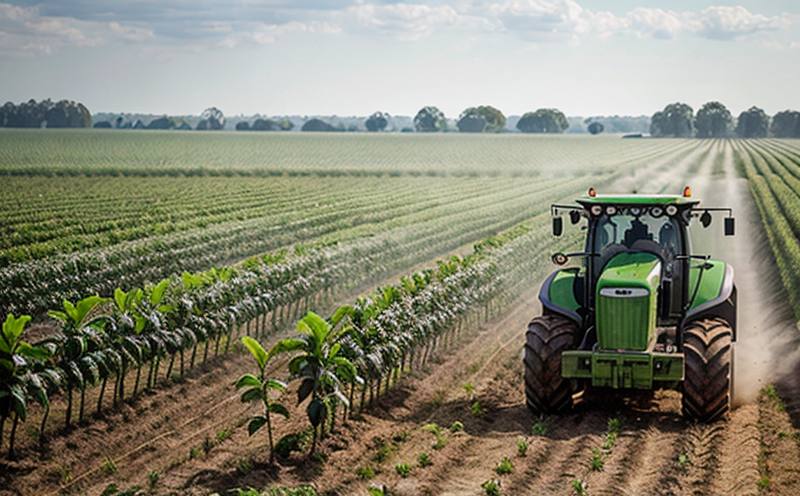EPA 8082 PCB Testing in Agricultural Samples
The Environmental Protection Agency (EPA) Method 8082 is a widely recognized standard for the determination of polychlorinated biphenyls (PCBs) in various environmental and industrial samples. This method has been specifically adapted to analyze agricultural samples, which can be contaminated with PCBs from historical uses of certain pesticides or fertilizers.
The primary purpose of EPA 8082 is to ensure the safety and compliance of agricultural products by identifying and quantifying PCB levels that may pose a risk to human health. This testing is crucial for quality control, regulatory compliance, and ensuring public safety in the food chain.
PCBs are toxic chemicals that can accumulate in the environment over time. Agricultural products contaminated with PCBs can lead to their unintended presence in foods, which could be harmful when consumed by humans or animals. This method provides a robust approach for detecting these contaminants at low levels, ensuring that agricultural products meet stringent safety standards.
The testing process involves several key steps: sample collection, preparation, extraction, and analysis. Samples are typically collected from various points within an agricultural setting, including soil, water, plant material, and animal feed. The samples are then prepared according to EPA 8082 guidelines, which include digestion with appropriate solvents.
The extracted PCBs are concentrated using a solvent-based system before being analyzed by gas chromatography (GC) or liquid chromatography coupled with mass spectrometry (LC-MS/MS). This ensures high sensitivity and specificity in detecting even trace amounts of PCBs. The method is validated to detect concentrations as low as 0.1 ng/g, which aligns with the EPA’s strict guidelines for agricultural safety.
The results from this testing are critical not only for compliance but also for identifying potential contamination sources and implementing corrective measures. This data can help in making informed decisions regarding production processes, storage conditions, and product distribution to minimize health risks.
It is important to note that EPA 8082 is part of a broader regulatory framework aimed at reducing the environmental impact of PCBs. By adhering to this method, agricultural producers can ensure their operations meet both national and international standards for chemical safety.
The process described by EPA 8082 is rigorous and precise, making it an essential tool in maintaining the integrity of agricultural products. This testing not only protects consumers but also supports sustainable agriculture practices that minimize environmental harm.
Given the complexity and importance of this testing, it is recommended to consult with a laboratory experienced in EPA 8082 methods to ensure accurate results and compliance. Proper training for personnel involved in sample collection and preparation is also crucial to maintain consistent and reliable data.
Scope and Methodology
EPA Method 8082 provides a comprehensive approach to the analysis of PCBs in agricultural samples. The method covers various sample types, including soil, water, plant material, and animal feed. It outlines the procedures for sample preparation, extraction, cleanup, concentration, and final determination by gas chromatography (GC) or liquid chromatography coupled with mass spectrometry (LC-MS/MS).
- Sample Preparation: Samples are digested using a combination of solvents to extract PCBs. This step is critical for ensuring that all target compounds are released from the matrix.
- Cleanup and Concentration: After extraction, the samples undergo cleanup steps to remove interfering substances. The concentrated extracts are then ready for analysis by GC or LC-MS/MS.
- Analysis: Gas chromatography (GC) coupled with mass spectrometry (MS) provides high sensitivity and selectivity necessary for detecting PCBs at very low levels. This ensures accurate quantification of the contaminants present in agricultural samples.
The method is validated to ensure accuracy and reliability, allowing laboratories to produce results that meet regulatory requirements. The validation process includes calibration with standard solutions and quality control measures such as duplicate analysis and recovery testing.
Industry Applications
EPA Method 8082 is particularly relevant for industries involved in agricultural production, processing, and distribution. Quality managers, compliance officers, R&D engineers, and procurement specialists rely on this testing to ensure the safety of their products and processes.
Quality Managers use EPA 8082 to monitor the quality of raw materials and final products, ensuring they meet regulatory standards. Compliance Officers apply this method to verify that operations comply with environmental laws and regulations related to PCBs in agricultural settings.
R&D Engineers can leverage EPA 8082 data to improve production processes by identifying sources of contamination and implementing preventive measures. Procurement teams use the results from this testing to assess suppliers and select those who meet stringent safety standards.
By incorporating EPA 8082 into their quality assurance programs, these industries can enhance product safety, protect public health, and maintain a positive reputation in the marketplace.
The method’s broad applicability extends beyond just agricultural products. It is also useful for environmental monitoring, waste management, and remediation projects where historical use of PCBs may be an issue.
Quality and Reliability Assurance
- Calibration Standards: The method uses certified reference materials (CRMs) to calibrate instruments accurately. This ensures that the instrument settings are consistent, leading to reliable results.
- Duplicate Analyses: Samples are often analyzed in duplicate to verify consistency and accuracy of the results.
- Recovery Testing: Known quantities of PCBs are spiked into blank samples to assess the recovery rate. This helps in validating the extraction efficiency and analytical precision.
- Quality Control Samples: Laboratories use quality control (QC) samples to monitor the performance of their testing processes over time. These samples are analyzed periodically to ensure that the method is consistently producing reliable results.
The combination of these techniques ensures that EPA 8082 provides accurate and reproducible results, which are essential for regulatory compliance and maintaining product safety.





